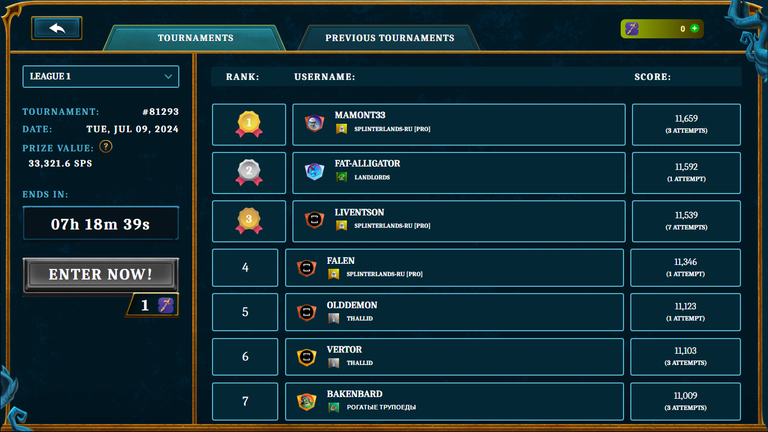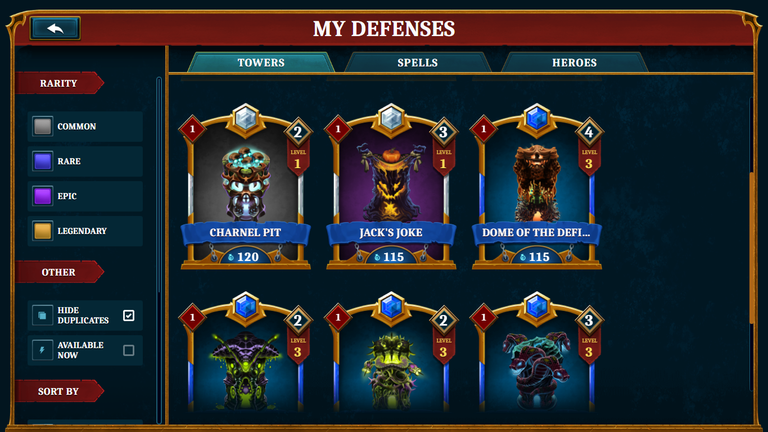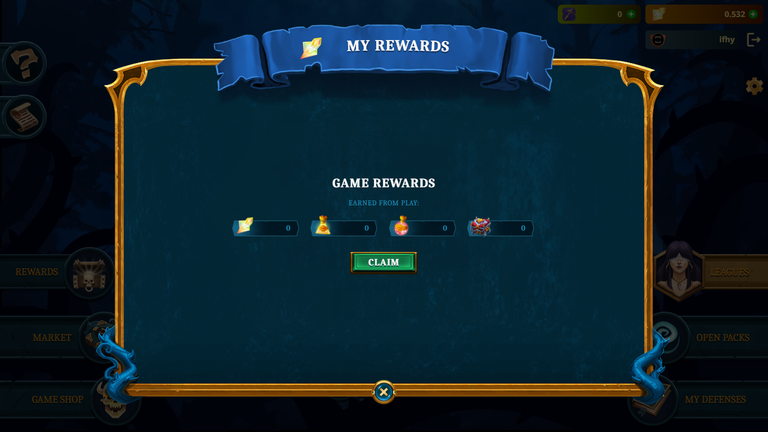SoulKeep Tower Defense: Could we Call it Play2Earn or Pay2Earn? [EN/PT]
When we talk about #Play2Earn games, the expectation is that players can earn substantial rewards through dedication and skill in the game. However, in the case of SoulKeep, the new title developed by the same team behind the success of Splinterlands, there is a critical point that deserves discussion: the Pay2Earn system, which seems blatantly implemented.
SoulKeep is a game that, like Splinterlands, is powered by the Hive Blockchain network. This detail may sound promising, as Hive has proven to be a robust platform for blockchain-based games, although some options are entirely IDLE GAMING, or seem experimental. However, the reality within the game paints a different picture since the only way to earn any significant rewards in SoulKeep is tied to participation and ranking in limited tournaments. This, in itself, would not be a problem if the distribution of these rewards were fair and accessible to a larger number of players. However, what we see is a rather confusing and limited distribution that does not consider the possible consequences of a rise in the game's popularity.

Imagine a scenario where only the top 100 players in a tournament are rewarded from the entire Splinterlands player ecosystem. It may seem like a reasonable number at first glance, but when we consider that the blockchain already reaches thousands of users, this limitation becomes concerning. Play2Earn games like SoulKeep should offer earning opportunities to a broader number of players, encouraging community participation and loyalty. However, with rewards restricted to such a small group, many players may feel demotivated and even excluded.
Moreover, the way rewards are distributed lacks transparency since there is no clarity about the criteria used to determine who gets what, which has caused me frustration. It seems they are just testing numbers. In an environment where trust is crucial, and it is already clear that they did not achieve this with their other project Genesis League, especially when dealing with cryptocurrencies and blockchain, this lack of clarity is a significant misstep.

Now, speaking about the game's mechanics, SoulKeep adopts classic tower defense elements. For many players, this is a nostalgic and engaging game style. The idea of defending your territory against waves of enemies using strategies and upgrades is something that attracts both casual and veteran players. However, even this mechanic is not enough to compensate for the reward system's problems.


An interesting suggestion would be to apply the same Splinterlands ecosystem in SoulKeep. For example, integrating summoner cards, which are a central element in Splinterlands, could bring an additional layer of strategy and familiarity for players. Even if these cards were used solely for aesthetic purposes, it would be a touch that could please the existing fan base. Speaking of casual gameplay, SoulKeep manages to deliver a reasonable experience. The interface is intuitive, and the pixel art + 3D drawn graphics are pleasing to the eye. The game does not require a significant time commitment, which is a positive point for players with tight schedules. However, this casual gameplay also means that players do not feel a great need to invest time or money in the game, especially when rewards are so limited.
Overall, when analyzing SoulKeep critically, it is difficult to give a high rating. The game's potential is undeniable, mainly considering the team's previous success with Splinterlands and the use of the Hive Blockchain. However, the flaws in the reward system and the lack of transparency are issues that cannot be ignored. The feeling is that the game could be much more than it currently is if there were a more inclusive and fair approach to the players. For now, a rating of 5/10 seems fair, reflecting both the positive aspects and the areas that need significant improvement.
If you are not yet part of the #Play2Earn game Splinterlands, consider registering through my referral link by clicking Here to be redirected to the registration page.

Versão em Português
Quando falamos sobre jogos #Play2Earn, a expectativa é que os jogadores possam obter recompensas substanciais através da dedicação e habilidade no jogo. Porém, no caso de SoulKeep, o novo título desenvolvido pela mesma equipe por trás do sucesso Splinterlands, há um ponto crítico que merece ser discutido: o sistema Pay2Earn, que parece estar descaradamente implementado.
SoulKeep é um jogo que, assim como Splinterlands, é alimentado pela rede Hive Blockchain. Este detalhe pode soar promissor, pois a Hive tem se mostrado uma plataforma robusta para jogos baseados em blockchain, embora algumas opções são totalmente IDLE GAMING, ou parece ser algo experimental. No entanto, a realidade dentro do jogo pinta um cenário diferente já que a única maneira de obter qualquer tipo de recompensa significativa em SoulKeep está atrelada à participação e classificação em torneios limitados. Isso, por si só, não seria um problema se a distribuição dessas recompensas fosse justa e acessível a um número maior de jogadores. No entanto, o que vemos é uma distribuição bastante confusa e limitada, que não considera as possíveis consequências de um aumento de popularidade do jogo.

Imagine um cenário onde apenas os 100 melhores jogadores em um torneio são recompensados de todo o ecossistema de jogadores Splinterlands, pode parecer um número razoável à primeira vista, mas quando consideramos que a blockchain já atinge milhares de usuários, essa limitação se torna preocupante. Jogos Play2Earn como SoulKeep deveriam oferecer oportunidades de ganho para um número mais amplo de jogadores, incentivando a participação e a lealdade a comunidade. No entanto, com recompensas restritas a um grupo tão pequeno, muitos jogadores podem se sentir desmotivados e até excluídos.
Além disso, a maneira como as recompensas são distribuídas carece de transparência já que não há uma clareza sobre os critérios usados para determinar quem recebe o quê, o que gerou para mim uma frustração, parece que eles apenas estão testando números. Em um ambiente onde a confiança é fundamental e já é claro que, eles não conseguiram isso com seu outro projeto Genesis League, especialmente quando estamos lidando com criptomoedas e blockchain, essa falta de clareza é um grande passo em falso.

Agora, falando sobre a mecânica do jogo em si, SoulKeep adota elementos clássicos de defesa de torres. Para muitos jogadores, este é um estilo de jogo nostálgico e envolvente. A ideia de defender seu território contra ondas de inimigos, utilizando estratégias e aprimoramentos, é algo que atrai tanto jogadores casuais quanto veteranos. No entanto, mesmo essa mecânica não é suficiente para compensar os problemas do sistema de recompensas.


Uma sugestão interessante seria aplicar o mesmo ecossistema de Splinterlands em SoulKeep. Por exemplo, integrar cartas de invocadores, que são um elemento central em Splinterlands, poderia trazer uma camada adicional de estratégia e familiaridade para os jogadores. Mesmo que essas cartas fossem usadas apenas para fins estéticos, seria um toque que poderia agradar a base de fãs existente. Falando de jogabilidade casual, SoulKeep até que consegue entregar uma experiência razoável. A interface é intuitiva e os gráficos em estilo pixel art + 3D desenhado são agradáveis aos olhos. O jogo não exige um grande compromisso de tempo, o que é um ponto positivo para jogadores que têm horários apertados. No entanto, essa jogabilidade casual também significa que os jogadores não sentem uma grande necessidade de investir tempo ou dinheiro no jogo, especialmente quando as recompensas são tão limitadas.
No geral, ao analisar SoulKeep de maneira crítica, é difícil dar uma nota alta. O potencial do jogo é inegável, principalmente considerando o sucesso anterior da equipe com Splinterlands e a utilização da Hive Blockchain. Contudo, as falhas no sistema de recompensas e a falta de transparência são questões que não podem ser ignoradas. A sensação é que o jogo poderia ser muito mais do que é atualmente, se houvesse uma abordagem mais inclusiva e justa para os jogadores. Por enquanto, uma nota de 5/10 parece justa, refletindo tanto os aspectos positivos quanto as áreas que precisam de melhorias significativas.
Se você ainda não participa do jogo #Play2Earn Splinterlands, considere se registrar através do meu link de referência, basta clicar Aqui para ser redirecionado para o registro.

Obrigado por promover a comunidade Hive-BR em suas postagens.
Vamos seguir fortalecendo a Hive